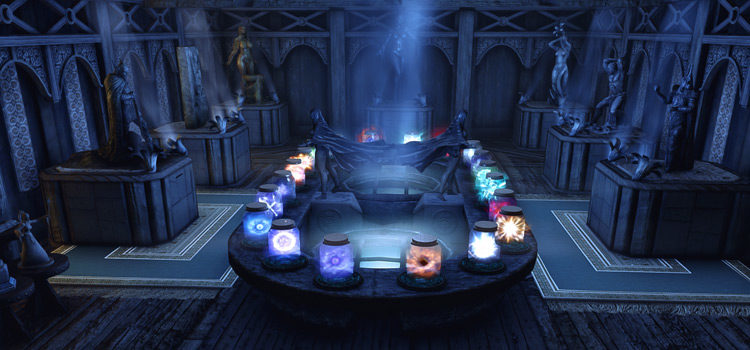Mage Hand: D&D 5e Spell Guide
This post may contain affiliate links. If you buy something we may get a small commission at no extra cost to you. (Learn more).
So you’re making a new character and it’s time to choose your cantrips.
While one of your cantrips should be a damaging spell, at least one of your cantrips ought to provide some utility.
Mage Hand can provide incredible utility and out-of-the-box solutions to any problem that your Dungeon Master throws at you.
Here’s our guide to one of the best utility cantrips in D&D 5e.
Mage Hand Spell Details
School: Conjuration
Level: Cantrip
Casting Time: One Action
Range: 30 feet
Components: Verbal, Somatic
Duration: One Minute
The spell Mage Hand creates a spectral hand within range.
It can handle ten pounds of weight, and you may use a new action to move the hand and use it to interact with objects.
Mage Hand acts as a third hand acting where you want to be, but can’t.
With enough planning and preparation, the cantrip can potentially be used in almost any scenario. Subtly influencing a social situation, poking holes in puzzles, creative combat use, and even specific ways to help with exploration.
A well prepared player can Mage Hand through most situations.
Who Gets Mage Hand?
The cantrip is on the Artificer, Bard, Sorcerer, Warlock, and Wizard spell lists.
The Arcane Trickster subclass of the rogue always gets it, along with two other cantrips from the Wizard list.
Mage Hand: Social Uses
Our spell has a very low amount of force that it can apply, preventing it from having direct combat uses.
But that low amount of force can still be applied for social purposes.
If you’re being watched or you can’t cross a certain threshold, you could still possibly poke someone to get their attention.
For the opposite effect, you could use Mage Hand to distract someone while you’re trying to sneak past them.
Puzzle Breaking Uses
The most common use of Mage Hand typically is to invalidate or ease traps and puzzles the DM comes up with.
A surprisingly common occurrence in puzzles is a component being out of reach, or partially out of reach of the players.
If you can reach an extra thirty feet, you can usually get around these restrictions.
If there’s danger involved in pulling a lever or pushing a button, you can sometimes escape this danger by being able to activate it from a distance.
Or if a trap has darkness as a component because the DM knows your party lacks darkvision, a torch only has a weight of one pound. So you can easily carry it to light the way.
Creative Combat Uses
As mentioned earlier in the social section, Mage Hand is designed to prevent direct attacks on a target or use of magic items.
That means we can still use mundane items for indirect combat use.
Most DMs would forbid the throwing of acid, alchemist’s fire, or caltrops at an enemy, since those are all obviously attacks.
However, throwing the alchemist’s fire or caltrops can act as a barrier to prevent movement.
The enemy would have to take damage or risk losing movement speed.
If they make the sacrifice in movement speed with caltrops to escape or move somewhere else, they can easily be followed by you or your party members.
In some specific situations, you could subtly prepare to kill a target outside of combat.
For example, the spell allows you to do something like open a vial. You could pour poison into a target’s cup. Something like would be the sort of indirect attack allowed by Mage Hand.
Mage Hand: The Down Sides
While there are some extreme uses of the spell, it has built-in limits to prevent it from being able to do absolutely everything.
First, Mage Hand can’t be used to attack. This prevents it from being used for long ranged melee builds. If not for this, the user could do a weapon attack from thirty feet away, or the sorcerer from sixty feet away, reducing the built-in armor and health vulnerability of arcane casters that would prevent them from getting too close to the target.
Next, Mage Hand cannot be used to use a magical item.
The rules of fifth edition are already designed under the assumption that magic items will be rather hard to find. And a DM allowing too many magic items can quickly destabilize a campaign.
Preventing a cantrip from using magic items is a further safeguard against the instability of magic items.
The spell prohibits the caster from using more than ten pounds of force.
This is meant to prevent things like shoving or lifting very heavy objects that would make the spell too hard to plan around for the DM.
Now with this particular rule, there are ways to get around it, if you can get creative.
But finally, Mage Hand is limited to simple interactions.
Example: you can open an unlocked door, but you can’t unlock a door.
This restriction is eased if you acquire Mage Hand through the Arcane Trickster subclass of the rogue.
As the Trickster, you can use the cantrip to try and steal from a target, plant something on a target, or pick a lock.
Fun & Creative Exploits
With something as open-ended as Mage Hand, there are always going to be things the designers won’t have thought about.
This list is by no means comprehensive.
But it’s a neat set of tricks and creative uses for Mage Hand that technically work.
Flying Halfling
Normally a Sorcerer, Warlock, or Wizard could use the third level spell Fly to be able to… well, fly.
But what if we wanted to fly with Mage Hand?
Our only problem is that Mage Hand has a weight limit of ten pounds. Halflings are the smallest of the core races, but they still weigh forty pounds.
But with the second level spell Reduce, their size and weight is reduced to one-eighth of the original, leaving us at an eight pound spellcaster.
With the Reduce-Mage Hand combo, a Sorcerer or Wizard could fly two levels earlier and use a spell slot one level lower.
This should also work with Gnomes, Kobolds, and some Goblins.
Extended Familiar
With the spell Find Familiar, you can cast touch spells through your familiar.
The limitation with this is that most familiar options have relatively low health and speed.
If necessary to reach someone far away, you can have the familiar be riding on you to share your initial movement speed, use your action to move the familiar another thirty feet, then they can move their own speed before next turn.
If you multiclass two levels or more into the Fighter, then you could Action Surge to cast the urgent touch spell on your turn.
Cloaked Scout
When you’re worried that there may be enemies hiding up ahead, you can summon your Mage Hand.
Throw a cloak on top of your Hand, and keep it thirty feet ahead of you.
There’s now a cloaked figure walking around as bait for any enemies you might be worried about.
Final Advice
Mage Hand is an incredibly useful and open-ended cantrip.
It can do many of the creative things like we discussed, as well as any others you can think of on your own.
If you do think of something that should work but is open to interpretation, give your DM a heads up to see if they’d allow it.
It would feel awful to plan around something that gets overruled at the last second. Not to mention, you want to maintain a good relationship with your Dungeon Master, yeah?
Good luck players, and may all your rolls be twenty.






